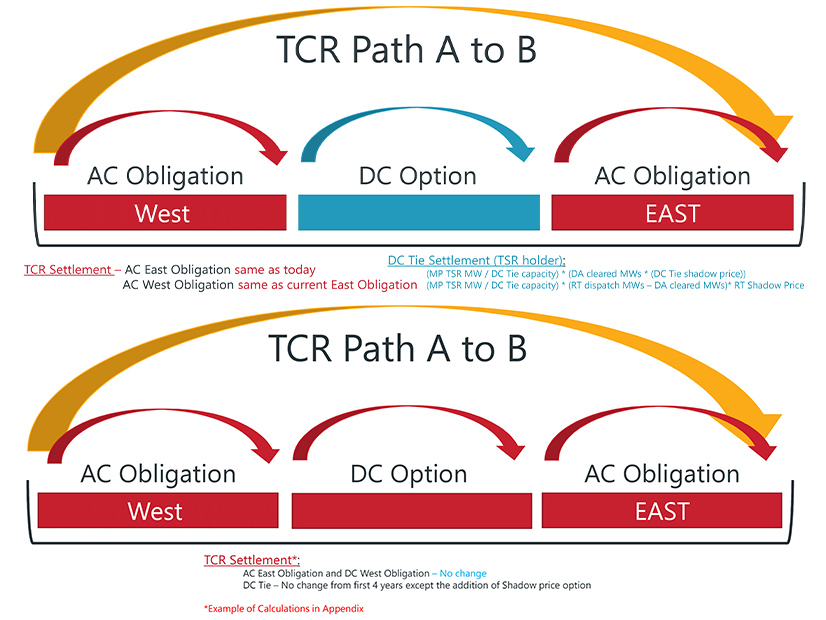
SPP’s Regional State Committee on Monday approved its Cost Allocation Work Group’s recommendation to approve a congestion-hedging solution for three DC ties that will connect the RTO’s Eastern and Western interconnection footprints.
The DC ties are owned by members of SPP’s Western Energy Imbalance Service market, providing up to 510 MW of capacity for RTO operations. Other DC ties could be added as the grid operator continues its Western expansion.
The DC Tie Solution Group developed the recommendations earlier this year in a white paper. It said the ties provide a necessary link to “facilitate single market operations” between the two interconnections and to ensure the best use of the facilities and maximum market benefit.
 Dana Murphy, OCC | SPP
Dana Murphy, OCC | SPPThe RSC has agreed that a DC tie cost-allocation methodology should be developed because of their unique operational characteristics and their market functionality. According to the white paper, the AC portion of the transmission-service paths that cross a specific DC tie will be awarded auction revenue rights (ARRs) and transmission congestion rights (TCRs) as a single path source to sink and then settled in multiple parts. The rights will be settled in two stages, with the AC portions settling in their respective interconnections. Day-ahead market congestion rent across the DC tie in both stages will be an option style, with the AC portions remaining as obligations.
The solution group recommends a four-year transition period. In the first four years, DC tie congestion settlement is removed from the TCR market. After that, the DC tie settlements process moves to SPP’s existing TCR market approach. TCR holders will be compensated for a specific tie’s congestion based on the awarded TCR megawatt amount.
Legacy facilities’ annual transmission revenue requirement will remain in their respective local transmission zone and will also remain part of the zone’s network and point-to-point rates. However, increased use of the DC ties will result in increased maintenance costs, the solution group said, with increased costs being borne fully by the tie owner’s zone unless cost recovery mechanisms are put in place.
The white paper creates two new revenue recovery mechanisms, an access charge and an incremental market efficiency use (MEU) charge, to recognize beneficiary-pays principles and recover increased operational costs due to market operations.
CAWG to Continue Safe Harbor Study
The committee directed the CAWG to spend at least another quarter exploring further changes to SPP’s three safe harbor criteria and its $180,000/MW limit and bring back the results to its October meeting.
The RSC’s review of safe harbor criteria is its first since 2018. A 2020 study was canceled in 2019 following the regulators’ decision to conduct in-depth safe harbor reviews every five years. (See “Regulators Cancel 2020 Safe Harbor Review,” SPP Regional State Committee Briefs: July 29 & Aug. 5, 2019.)
The reviews are intended to determine whether modifications should be made to the thresholds used to determine what project costs should be borne by the load-serving entities (LSEs) making long-term transmission service requests (TSRs).
SPP’s aggregate transmission service study process combines into a single study all long-term point-to-point and designated network resource requests received during a specified time period. The RTO splits the costs of transmission projects between the entire SPP footprint and the LSEs purchasing transmission service for designated resources — those used to meet the LSE’s capacity margin requirement.
The safe harbor exempts LSEs from upgrade costs when a TSR meets the aggregate studies’ waiver criteria, which include:
- wind generation not exceeding 20% of designated resources;
- a minimum five-year term for designated network resources TSRs; and
- designated resources not exceeding 125% of forecasted load.
The CAWG will bring back any modifications to the criteria or the amount. Several states have expressed an interest in further evaluating the 125% load and 20% wind criteria, regulatory staff said.
Travel Costs Increase Budget
The RSC approved a proposed budget for 2023 that reflects rising travel costs, despite a reduction of in-person meetings from four to two.
The total budget of $424,500 includes $270,00 for travel and meetings, an almost 57% increase from last year.
The committee is more than $123,000 under this year’s budget. Members have spent more than $37,000 of a budgeted $86,000 on travel and meetings.
Members, who will only meet twice in person this year, discussed the possibility of a third face-to-face meeting next year. Minnesota’s John Tuma, sitting outside in what he described as 76-degree temperatures and mild humidity, suggested the RSC gather in the Minneapolis-St. Paul area for its next July meeting.
Fiegen to Chair Nomination Committee
Members selected South Dakota’s Kristie Fiegen to chair the RSC’s Nomination Committee, where she will be joined by Arkansas’ Ted Thomas and Missouri’s Scott Rupp.
They will be responsible for bringing the 2023 proposed leadership slate to the RSC’s October meeting. They will also have to select at least one new member for the committee, as Oklahoma’s Dana Murphy is term-limited after this year.


